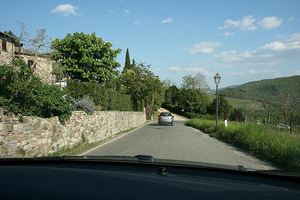 A discussion of the different kinds of roads in Italy leads me to this point, and my answer is a resounding yes. That giant Michelin map you got to help you figure out what cities you were watching zoom by outside the train window is great for an overview of the country, but if you’re going to be doing more driving in Italy than just going from big city to big city I highly recommend buying a much more detailed map – and buying it in Italy.
A discussion of the different kinds of roads in Italy leads me to this point, and my answer is a resounding yes. That giant Michelin map you got to help you figure out what cities you were watching zoom by outside the train window is great for an overview of the country, but if you’re going to be doing more driving in Italy than just going from big city to big city I highly recommend buying a much more detailed map – and buying it in Italy.
The Touring Club Italiano makes some very nice driving maps, so if you can find one of those that’s a good option. But many towns sell really specific regional maps – and I’m talking about specificity on the scale of “this is a map of just the Chianti region, not all of Tuscany” – which are ideal for drivers. They’re so detailed they could be a bit daunting at first, but they have the benefit of being more precise so you stand a better chance of figuring out just where you are when you eventually get lost and stop to ask directions.
On the Autostrada, the maximum speed is 130km/h in most cases, although a law passed in 2003 changed it to 150km/h on some 3-lane highways that have emergency lanes. On other roads, the maximum speed can vary from 110km/h to 50km/h, so the best advice is to pay attention to the road signs and see what the posted speed limit is. You don’t want to get pulled over for speeding in Italy – the fines are hefty.
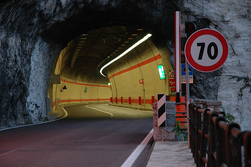 Speed limit signs in Italy are round and white with a red circle around them and the speed – in kilometers per hour – in black in the center. An example is in the photo to the right.
Speed limit signs in Italy are round and white with a red circle around them and the speed – in kilometers per hour – in black in the center. An example is in the photo to the right.
Note that when it’s been raining heavily, the speed limit drops by 10-20km/h – which may or may not be posted. So if the roads are wet, slow down.
No matter what you’re used to doing at home, the idea of the left lane being used strictly for passing is much more adhered to in Italy. If you’re just cruising along, get into the right lane. Pass on the left, and then get back into the right lane. Additionally, in Italy they keep their directional signal on while they’re passing and don’t turn it off until they’re moving back into the right lane – this indicates that they’re just going to be using the left lane for passing, and won’t hang out there.
All cars are required to have their headlights on at all times while driving, day or night.
Seat belts must be worn at all times.
Mobile phones may only be used with a headset or hands-free device.
All cars must have “safety vests” in the car – those reflective vests – in case you need to pull over on the road and get out of the car. They’re mandatory in several European countries now, and if you’re renting a car make sure the vests are in the car before you drive away from the rental car agency. Also, put the vests in the car itself, not in the trunk – the idea is you put them on before you get out of the car in an emergency situation, so having them in the trunk may not be considered in compliance with the law.
Italy’s drunk-driving laws are very strict – don’t drink and drive!
>> Italy beefed up its drunk driving laws in the summer of 2010, along with a few other strict driving laws. Read all about the updated driving laws in Italy before you go.
In addition to the speed limit signs discussed and pictured above, there are many Italian road signs which are self-explanatory. A stop sign is red, octagonal, and even says STOP – in English – in the center. Parking areas are indicated by a big blue square with a white P in the center.
But there are also some signs which require a bit of explanation. Here are some of the other road signs in Italy which you may see and not understand:
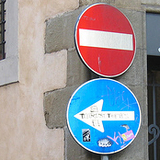 Do Not Enter – This is a red circle with a white horizontal bar through the middle.
Do Not Enter – This is a red circle with a white horizontal bar through the middle.
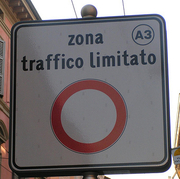 No Vehicles Allowed – This one, counterintuitively to me, is white & round with a red circle around the border. If it’s specifically saying no cars can go in that way but other motorized vehicles can, there will be a picture of a car in the middle of the sign.
No Vehicles Allowed – This one, counterintuitively to me, is white & round with a red circle around the border. If it’s specifically saying no cars can go in that way but other motorized vehicles can, there will be a picture of a car in the middle of the sign.
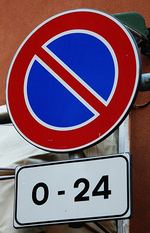 No Parking – This is circular with a red border and red slash through the middle (sometimes two), and a blue background.
No Parking – This is circular with a red border and red slash through the middle (sometimes two), and a blue background.
One Way – This is a rectangular sign win an arrow pointing out the appropriate direction, and the words “SENSO UNICO” in the arrow.
No Passing Zone – On roads that only have one lane in each direction, the places where passing is prohibited are indicated by a round white sign with a red border and two cars in the center – the right car is black, and the left car is red. There’s no line through it, but by making the left car red they’re telling you that overtaking isn’t allowed in that area.
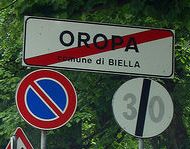 End of a Zone – In Italy, when a particular temporary restriction for an area has come to an end – like a slower speed limit through a town, or a no-passing area – the way they show you that the previous restriction is no longer in effect is using the same sign they used to tell you it was starting… Only this time it’s got a line through it. For instance, in the picture to the right you’ll see two examples of signs indicating the end of things. First, the in-town speed limit of 30km/h is no longer the rule, so you can go back up to whatever it was before they lowered it to 30. Second, you’re now leaving the town of Oropa, so there’s a big line through the sign with the town’s name.
End of a Zone – In Italy, when a particular temporary restriction for an area has come to an end – like a slower speed limit through a town, or a no-passing area – the way they show you that the previous restriction is no longer in effect is using the same sign they used to tell you it was starting… Only this time it’s got a line through it. For instance, in the picture to the right you’ll see two examples of signs indicating the end of things. First, the in-town speed limit of 30km/h is no longer the rule, so you can go back up to whatever it was before they lowered it to 30. Second, you’re now leaving the town of Oropa, so there’s a big line through the sign with the town’s name.
>> SlowTravel Italy has a great section on Italian road signs. The main page is here, and on the lower right-hand part of the menu you’ll find different sections for different kinds of road signs (like Restriction, Warning, Necessity, Helpful, etc.). The list is quite comprehensive, and there are pictures so you can see what they each look like.
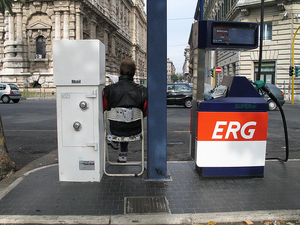 Getting gas in Italy is going to be just like getting gas anywhere else. The biggest thing to pay attention to is the type of gas you’re supposed to be putting in your rental car. The different kinds of gas in Italy are “benzina” (behn|ZEE|nah), which is unleaded gas, and “gasolio” (gahz|OHL|yoh), which is diesel.
Getting gas in Italy is going to be just like getting gas anywhere else. The biggest thing to pay attention to is the type of gas you’re supposed to be putting in your rental car. The different kinds of gas in Italy are “benzina” (behn|ZEE|nah), which is unleaded gas, and “gasolio” (gahz|OHL|yoh), which is diesel.
It’s imperative that you find out from the rental car agency what type of fuel goes into the car you’re renting. Diesel cars are much more common in Italy than they are in, say, the U.S., so don’t assume that the little sedan you’ve rented takes normal gas just because it looks like it would take normal gas back home. Screwing up the type of fuel you put in a car is a costly mistake.
Note that diesel is almost always cheaper than unleaded, so if you’ve got a choice, rent a diesel car.
There are both self-service and attended gas stations in Italy; it’s pretty obvious when you’ve pulled into one of the former, as there’s no one there to help! The good thing about self-serve stations is that they’re less likely to close unexpectedly.
>> Although the prices are outdated, SlowTravel Italy has a nice overview of what it’s like to get gas in Italy – both at attended stations and self-serve stations, including great step-by-step instructions on using a self-serve automated machine to pay.
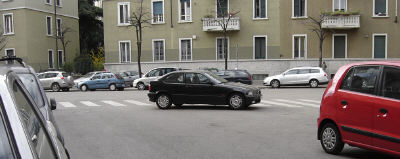 Parking in Italy may be one of the biggest mysteries to visitors – although I’m not sure the Italians understand it much better. If they do, they almost make a game of ignoring the rules or just creatively skirting them.
Parking in Italy may be one of the biggest mysteries to visitors – although I’m not sure the Italians understand it much better. If they do, they almost make a game of ignoring the rules or just creatively skirting them.
Italian Notebook shared the story of a few residents of one street in Rome just repainting parking lines after the street painters had left to keep their parking situation as it had been. I photographed some of the creative parking in Milan, including someone using the middle of a pedestrian crossing in the middle of the street as a parking space. And in Liguria, Wandering Italy notes that the local superstition is that when you drive into town you should rub your own buttocks – “with sincerity” – and you’ll find a parking space.
Having said all of that, if you want to know about the particular parking rules in Italy – what the colored lines on the streets mean, and how to pay for the paid parking spaces – then this overview at SlowTravel Italy is a good place to start.
Along many of Italy’s roads, there are emergency call boxes strategically located – they’re about every 2km or so on the Autostrade, less frequent along other roads (if they exist at all). The emergency road service number to dial is 116.
Here are a couple of videos to give you a sense of what it’s like to drive in Italy.
First, this video shows a vespa snaking its way through Naples traffic.
Second, this car is winding its way along the Amalfi Coast, and the video is like a little Italian driving lesson as well.
>> The always-resourceful Moving2Italy2 blog has a page about driving in Italy that’s full of links to useful sites, including one that gives you an idea of driving distances and times between major points in Italy. While this site is generally really tough to read (all lists and links), it’s always a good resource for information and in this case also includes a series of personal observations by the blog writer, who lives in Tuscany. You’ll find those under “Observations.”
photos, top to bottom, by: lorca56, larry wfu, mava, Sacred Destinations, madcap676, MichaelTurk, Simone Ramella, AmUnivers, cesare g, brianwallace, Jessica Spiegel